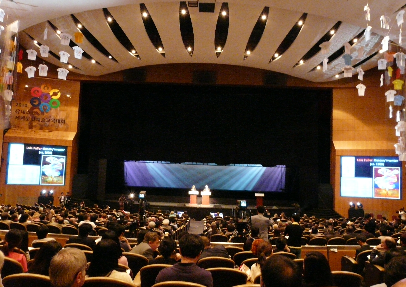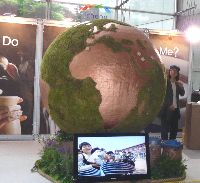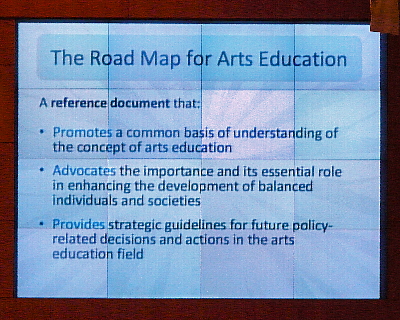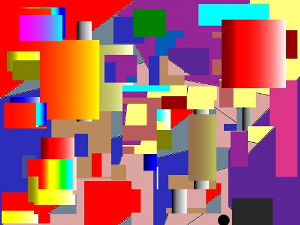|
|
The Vision of Arts Education Program
The 2nd WORLD CONFERENCE ON ARTS EDUCATION
25-28 May 2010, Seoul, Republic of Korea |
 |
Establish international research networks to promote the sustainability of arts education.
Elaborate an international
guide for arts education advocacy.
|
1. Affirm arts education as the foundation of a balanced
cognitive, emotional, aesthetic and social development of children and youth
2. Strengthen arts education, including the experience of
the arts and collaboration with artists within and between in‐school and
out‐of-school
education
3. Empower teaching and artist communities with sustainable
arts education training
4. Promote and foster lifelong learning in, about and
through arts education
5. Recognize and develop the socio‐cultural well-being
dimensions of arts
education
6. Support and enhance the role of arts education in the promotion of social
responsibility, social cohesion, cultura diversity and intercultural dialogue
7. Foster capabilities through arts education to respond to
maior global
challenges, from peace to sustainability
8. Build capacities for arts educatin leadership, advocacy
and policy
development processes
9. Develop diverse arts education partnerships among various stakeholders
and sectors, from culture to industry
10. Stimulate dialogue and exchange between theory, research
and practice in arts education
10 Development Goals in Seoul
 |
|
1. The arts teach children to make good judgments about qualitative
relationships.
Unlike much of the curriculum in which correct
answers and rules prevail, in the arts, it
is judgment rather than rules that
prevail.
2. The arts teach children that problems can have more than one
solution
and that questions can have more than one answer.
3. The arts celebrate multiple perspectives.
One of their
large lessons is that there are many ways to see and interpret the world.
4. The arts teach children that in complex forms of problem
solving
purposes are seldom fixed, but change with circumstance and
opportunity. Learning in the arts requires the ability and a
willingness to surrender to the unanticipated possibilities of the work as it
unfolds.
5. The arts make vivid the fact that neither words in their literal
form nor numbers exhaust what we can know. The limits of our language
do not define the limits of our cognition.
6. The arts teach students that small differences can have large
effects.
The arts traffic in subtleties.
7. The arts teach students to think through and within a
material.
All art forms employ some means through which images
become real.
8. The arts help children learn to say what cannot be
said.
When children are invited to disclose what a work of art helps
them feel, they must reach into their poetic capacities to find the words that
will do the job.
9. The arts enable us to have experience we can have from no other
source
and through such experience to discover the range and
variety of what we are capable of feeling.
10. The arts' position in the school curriculum symbolizes to the
young
what adults believe is important.
National Art Education Association
SOURCE: Eisner, E. (2002). The Arts and the Creation of Mind, In Chapter 4, What
the Arts Teach and How It Shows. (pp. 70-92). Yale University Press. Available
from NAEA Publications.
|
Makio, K.: The Aims of Visual Arts Education
|
1. Visual Arts Education uses hands and tools/implements, and creates what
we need to live. (Origin of Human Civilization)
2. Visual Arts Education provide visual literacy in the various modes of
visual communication to include drawing, craft, digital art, studio production,
art history, aesthetics and criticism. (Visual Literacy)
3. Visual Arts Education confirms the world and expression of children,
and allows them to express themselves appropriately for their age. (Advocacy
of Child-ness)
4. Visual Arts Education creates tools, and designs the earth and the world by using them beautifully.
(Tools and Technology in Harmony)
5. Visual Arts Education confirms each child’s individual sense and expressiveness,
assigns to relative values, and allows children to express their own feelings.
(Respect of Individuality)
6. Visual Arts Education thinks using eyesight/images, and integrates concrete
images into words and numbers. (Visual Thinking)
7. Visual Arts Education attempts to teach children to dream and to experience the joy of creation, not knowledge or skills alone. (Joy of Creativity)
For that reason, visual art education teaches the basics while
emphasizing multiple kinds of creative art experiences. (Enthusiasm for
Creativity)
8. Visual Arts Education uses the specific “expressive and appreciative”
activities that children use to create art to teach them to express themselves
in many ways and to live their own lives. (Self-expression)
9. Visual Arts Education teaches integration and harmony in the various
relationships between people, as well as in tools, materials, and knowledge.
(Self-control and Cooperation) (Hands-on Projects)
10. Visual Arts Education turns Destructive Energy into Constructive Artwork. (Art Therapy)
11. Visual Arts Education aims at child-focused activities, and is opposed
to instructors teaching unilaterally using particular teaching methods
such as XX. (Opposition to Uniformity)
12. Visual Arts Education is based on a broad specialization in creative
arts and consideration for children. Individualized instruction appropriate
to each child is the ideal. (Individual Instruction)
13. Visual Arts Education Education develops a lifelong love of creative
arts, a sense of beauty, and a rich capacity for self expression. (Self-realization)
14. Visual Arts Education enhances culture and fine arts for real development
of human beings, and protects traditional cultural assets and copyrights.
(Protection and Development of Culture and Fine Arts)
15. Visual Arts Education aims to build personalities able to deal proactively
with all future issues with creativity and with self-sufficiency. (Contributing
to the Society of the Future)
16. Visual Arts Education is inviting students to create a vision of Peace. (Peacemaking !)
16 Development Goals
|
|
 |
Shinozaki Elementary School
Computer Graphic Gallery
|
Makio, K.: Nine Lessons the Arts Education Teach
|
|
1. Arts education lets each individual student delineate his/her own dreams.
<Dream Power>
2. Arts education gives students an impression of the value of beauty with
an awareness of society and the earth that will last for a lifetime. Students
also receive a sense of artistic judgment conscious of those around them
as they act.
3. Arts education trains students in sensitivity and practical skills that
encourage the development of a creative lifestyle and a harmonious society,
as well as a beautiful earth.
4. Arts education is concerned with instruction on the individual level.
It integrates knowledge and experience to foster a temperament and ability
that is both expressive and capable of superior problem solving.
5. Arts education is concerned with the individual minds of students. It
trains in a richly human experience that has self-discipline, cooperativeness
with others, concern for others, and emotional depth.
6. Arts education is concerned with the individual lives of students. It
provides enjoyable experiences of self-expression, and encourages students
to think about living lives true to themselves.
7. Arts education is concerned with the individual profession of students.
It improves skills, provides an experience of the delight in being true
to oneself, and fosters creative ability in the workplace.
8. Arts education is concerned with technology. It enhances goals and safety,
fosters delight in utilizing technology, and creates designs concerned
with beauty that connect technology (machinery) with man.
9. Arts education is concerned with society. It suggests and is directly
concerned with social creativity that is peaceful and beautiful. Imaginative
thinking is at the core of art.
9 Lessons the Arts Education Teach |
Copyright (C) 2022 Makio Kawashima, Japan. All Rights Reserved.
10 Development Goals in Seoul: http://www5f.biglobe.ne.jp/~eLearning/Goals.html
|
|
|

